| |
 Click to Enlarge
Click to Enlarge
|
Density Experimentation Kit
See Enlarge
|
|
|
|
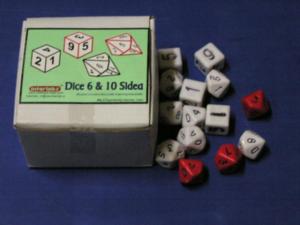 Click to Enlarge
Click to Enlarge
|
dice set of 60 30 six sided and 30 ten sided
See Enlarge
|
|
|
|
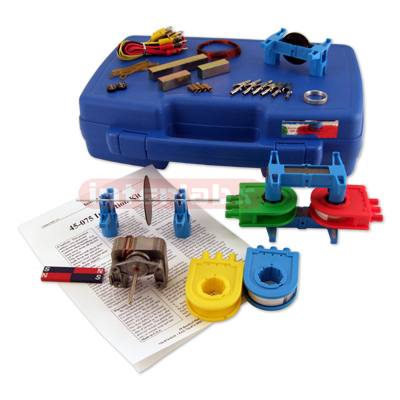 Click to Enlarge
Click to Enlarge
|
Induction Kit (96)
| This comprehensive kit contains all of the necessary pieces for an understanding of electrical induction, magnetic fields, electromagnets, motors, AC/DC motors, basic transformers, series and parallel transformers, and many other applications. The kit features snap together frames for laminated or solid core transformer frames, motor mounts, field coils, and Thompson ring experiments. Includes fitted case and instructions. Requires power supply and meter. |
| 45-075 Induction Kit includes: |
| • Laminated "U" core in plastic frame |
| • Laminated "I" beam in plastic frame |
| • Empty frame for iron cores or motor mounting |
| • (2) small frames for attachments |
| • 600 turn primary coil |
| • 300 turn secondary coil |
| • (2) empty coils for winding experiments |
| • Long solid iron core |
| • (2) short solid iron cores |
| • AC induction motor in laminated frame |
| • Coil of magnet wire for winding |
| • Levitating Thompson ring |
| • Magnetic motor rotor |
| • (2) mini compasses |
| • (2) bar magnets |
| • Alligator clips |
| • Rubber bands |
| • Winding coil contacts |
| • Aluminum Lenz' Law disc on shaft |
| • Connecting wires with banana plugs |
| • Sturdy fitted case |
| • Instructions |
See Enlarge
|
|
|
|
 Click to Enlarge
Click to Enlarge
|
Induction Kit (LSE)
| This comprehensive kit contains all of the necessary pieces for an understanding of electrical induction, magnetic fields, electromagnets, motors, AC/DC motors, basic transformers, series and parallel transformers, and many other applications. The kit features snap together frames for laminated or solid core transformer frames, motor mounts, field coils, and Thompson ring experiments. Includes fitted case and instructions. Requires power supply and meter. |
| 45-075 Induction Kit includes: |
| • Laminated "U" core in plastic frame |
| • Laminated "I" beam in plastic frame |
| • Empty frame for iron cores or motor mounting |
| • (2) small frames for attachments |
| • 600 turn primary coil |
| • 300 turn secondary coil |
| • (2) empty coils for winding experiments |
| • Long solid iron core |
| • (2) short solid iron cores |
| • AC induction motor in laminated frame |
| • Coil of magnet wire for winding |
| • Levitating Thompson ring |
| • Magnetic motor rotor |
| • (2) mini compasses |
| • (2) bar magnets |
| • Alligator clips |
| • Rubber bands |
| • Winding coil contacts |
| • Aluminum Lenz' Law disc on shaft |
| • Connecting wires with banana plugs |
| • Sturdy fitted case |
| • Instructions |
See Enlarge
|
|
|
|
 Click to Enlarge
Click to Enlarge
|
Induction Kit (LSE)
| This comprehensive kit contains all of the necessary pieces for an understanding of electrical induction, magnetic fields, electromagnets, motors, AC/DC motors, basic transformers, series and parallel transformers, and many other applications. The kit features snap together frames for laminated or solid core transformer frames, motor mounts, field coils, and Thompson ring experiments. Includes fitted case and instructions. Requires power supply and meter. |
| 45-075 Induction Kit includes: |
| • Laminated "U" core in plastic frame |
| • Laminated "I" beam in plastic frame |
| • Empty frame for iron cores or motor mounting |
| • (2) small frames for attachments |
| • 600 turn primary coil |
| • 300 turn secondary coil |
| • (2) empty coils for winding experiments |
| • Long solid iron core |
| • (2) short solid iron cores |
| • AC induction motor in laminated frame |
| • Coil of magnet wire for winding |
| • Levitating Thompson ring |
| • Magnetic motor rotor |
| • (2) mini compasses |
| • (2) bar magnets |
| • Alligator clips |
| • Rubber bands |
| • Winding coil contacts |
| • Aluminum Lenz' Law disc on shaft |
| • Connecting wires with banana plugs |
| • Sturdy fitted case |
| • Instructions |
See Enlarge
|
|
|
|
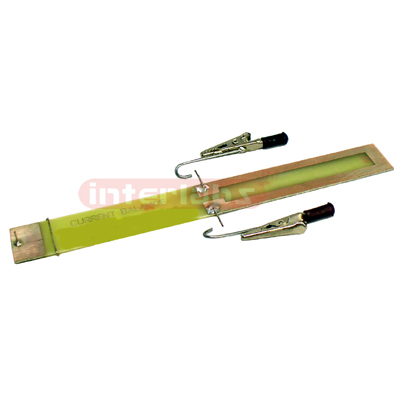 Click to Enlarge
Click to Enlarge
|
Current Balance PSSC (LSE)
Show the force a magnetic field exerts on a current carrying wire. Use this effect to measure the strength of the magnetic field at the center of a solenoid.
This accessory can be added to the Air Core Solenoid to measure the force experience by a conducting loop carrying an electric current when it is placed in a magnetic field.
The kit consists of the following items:
16.5 cm balanced, printed conductive blade, bounded by a conducting loop, that is wired to two conducting axles and two alligator clips which are used to connect the device to the Air Core Solenoid.
See Enlarge
|
|
|
|
 Click to Enlarge
Click to Enlarge
|
Electric Field Apparatus (LSE)
Our Electric Field Apparatus is designed to show the lines of an electric field produced by a large electrostatic charge, such as the one generated by a Van de Graaf Generator or Wimshurst Machine.
The cost effective apparatus is great for classroom use because it can be placed on an overhead projector for viewing by an entire class.
Included:
(1) electric field apparatus (plastic petri dish on acrylic base with feet and terminal pillars), (1) bottle of castor oil, (1) packet of iron filings, (2) point charges, (2) charged plates and instructions
See Enlarge
|
|
|
|
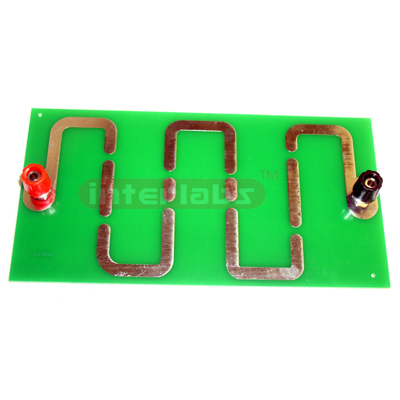 Click to Enlarge
Click to Enlarge
|
Lightning Leaper (LSE)
The path of least resistance can often lead to complications and unexpected outcomes. This is certainly true of our creatively named "Lightning Leaper". We provide an insulating plate with two binding clips on either end for connecting to a Van de Graaff generator. On the plate's surface, an incomplete metallic path-with eight small gaps-is drawn in a zig zag pattern. Anyone can see that the shortest path between the binding clips is definitely not the metallic path. Yet, the discharge from the Van de Graaff follows just this path-watch as the electricity leaps over each gap!
This plate can be suspended from an insulating stand and connected at either end to a Van de Graaff generator. For hardier souls, it can be held in the hand close to the active Van de Graaff.
For maximum "bang", try in a darkened room.
See Enlarge
|
|
|
|
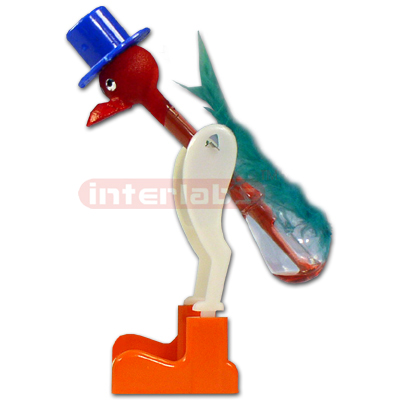 Click to Enlarge
Click to Enlarge
|
Drinking Bird (LSE)
Demonstrate the relationship between pressure and temperature with our classic 15-070 Drinking Bird!
The laws of physics come alive when our low pressure glass bird dips his head for another drink. He will keep on drinking until he can no longer wet his beak. As the water evaporates from his head, the cooler part of his glass body draws the liquid up to his head. This makes him tip down for another drink.
MSDS available upon request, contains dichloromethane.
See Enlarge
|
|
|
|
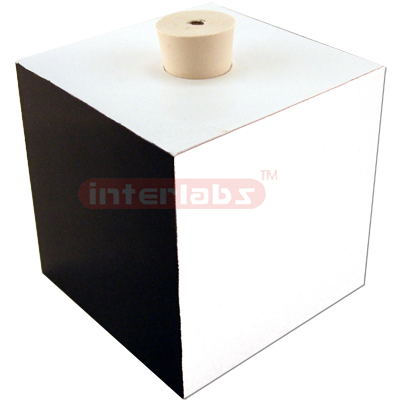 Click to Enlarge
Click to Enlarge
|
Leslie's Cube (LSE)
Leslie's Cube demonstrates heat absorption and radiation. The cube features four sides with different finishes:
Flat Black
Gloss Black
White
Shiny Tin
The top of the cube is fitted with a rubber stopper with a hole for the insertion of a thermometer (not included). When a lamp or other radiation source is shined onto the differing sides, students can investigate the varying properties of surface finishes by measuring the rate of heat absorption in water inside the can. They may then measure the rate at which heat is released from the cube through a given side. The thermal difference between the sides may be as great as 20 times. The cube is 4 inches on each side.
See Enlarge
|
|
|
|
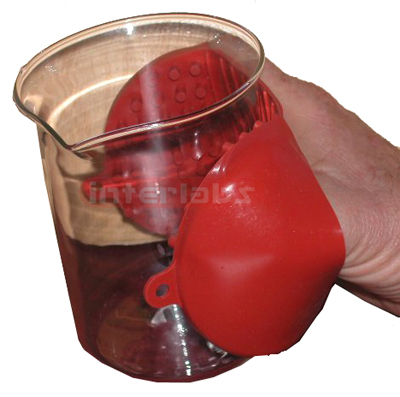 Click to Enlarge
Click to Enlarge
|
Hot / Cold Hand Protector Glove (LSE)
One size rubber mitt that fits most hands and protects hands when handling hot or cold labware. Features studded surfaces for good grip.
See Enlarge
|
|
|
|
 Click to Enlarge
Click to Enlarge
|
Raymond Thermal Expansion Demonstrator (LSE)
| Here's a new twist on the "Ball and Ring" that proves that metal expands when heated. |
| •Why does the rod fit in the gauge at room temperature, but not when heated? |
| •Demonstrate the linear and spherical expansion of metal when it is heated. |
Why do bridges need expansion joints? Why are small gaps left between metal sleepers on railway tracks? Why are airplanes designed so that they can expand without breaking?
The "Ball and Ring" demonstration has been around awhile and attempts to answer these questions. The ball fits through the ring until it is heated and expands just enough to become too big. But just when you thought this experiment was old hat, we've developed a new twist. Since it was invented by our late owner, engineer Ray Bell, we'd like to call it the "Bell" and Ring - but we don't dare.
This precision-machined thermal expansion demonstration is literally "two for one." It demonstrates both linear and spherical expansion, unlike the traditional "Ball and Ring." It consists of two pieces, both with wooden handles for safety. The first is a rod that is 7.5 cm long and 1 cm in diameter. The other is a gauge with a precision-machined 7.5 cm slot with two holes about 1 cm in diameter.
(But in this case, the "about" is critical. Perform the demonstration to find out why.)
|
How it works:
At room temperature, the rod fits snugly inside the slot and either end fits into either hole in the gauge. Now heat the rod with a propane torch. The metal - as do most materials - expands when heated. The rod no longer fits in the slot. It does fit in one of the holes but does not fit in the other, which gives a good inkling of how infinitessimally small the thermal expansion can be while still wreaking havoc with civil engineering projects. |
See Enlarge
|
|
|
|
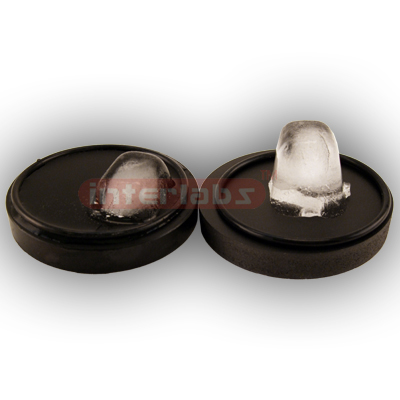 Click to Enlarge
Click to Enlarge
|
Ice Melting Set (LSE)
A new twist on the ?black box?............ Our black blocks look alike, but do they feel alike? More importantly, do they act alike?
Here?s an interesting and irrefutable way to prove the difference in heat conductivity in different metals. Place an ice cube on each of two similar black blocks at room temperature, sit back and watch. Do they melt at the same rate? Why or why not? The ?cooler? block is of aluminum, which is an excellent conductor of heat. The ?warmer? block is of plastic foam, which is a very poor conductor of heat. Contains: two black blocks with rim to prevent spillage, instructions with theory. This demo is great for all the doubting Thomases in your elementary through high school classes. Fast, easy and fascinating.
See Enlarge
|
|
|
|
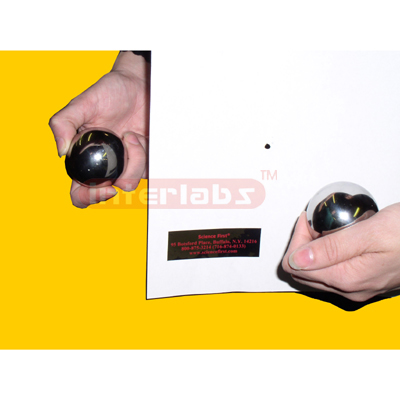 Click to Enlarge
Click to Enlarge
|
Energy Transformation Kit (LSE)
| Have a "smashing" good time converting mechanical energy to heat. |
Bet you never knew converting mechanical energy to heat energy could be so - in a word - entertaining.
Merely striking our two precision machined balls together will create enough heat at the point of contact to burn a hole in a sheet of paper. You'll see no flame, but a charred hole appears instantly along with a smell of burning paper.
Why? The First Law of Thermodynamics states, "Energy can neither be created nor destroyed." In other words, it merely changes its form - in this case, from mechanical energy (striking two balls together) to heat (evidenced by the hole burned in the paper).
|
How to use:
1. Put on safety glasses.
2. Have a helper hold a piece of paper in the air.
3. Hold a ball in each hand. From opposite directions, strike the paper with both balls. The balls should collide head-on with enough force to burn a hole in the paper.
4. If no burn hole appears, try again. The balls must move quickly and must hit each other squarely.
|
| Kit includes: |
| •Two precision machined 454 gram balls, hardened with chrome-plated steel. |
| •Instructions with historical perspective. |
| Meets National Science Education Standards and Benchmarks for Science Literacy! |
See Enlarge
|
|
|
|
 Click to Enlarge
Click to Enlarge
|
Radiation Can Set (LSE)
| Not all colors are created equal. Investigate how color can influence absorbing and radiating energy. |
• Observe how surface color affects rate of energy absorption by an object |
| • Observe how surface color affects rate of energy radiation from an object |
Light and heat - where would we be without them? Not alive on our wonderful earth, that's for certain. We've all seen pictures of the Earth's surface taken from an airplane that show the many types of features - water, ice, rocks, sand, soil and plants - that cover its surface. But do all these objects absorb incoming solar radiation equally? Once heated by the sun, do they all give off heat energy equally?
|
Find out with these two differently colored cans in our low-cost Radiation Can Kit. All you'll need are thermometers and a lamp to provide a source of heat.
|
How to use:
Exploring radiation and absorption.
1. Place black and silver containers near each other with thermometers inserted in each.
2. Angle a lamp so the light points directly at the sides of both containers.
3. Read off temperatures of each, with the light on, then off. Observe and record 10 minutes. |
See Enlarge
|
|
|
|
|







